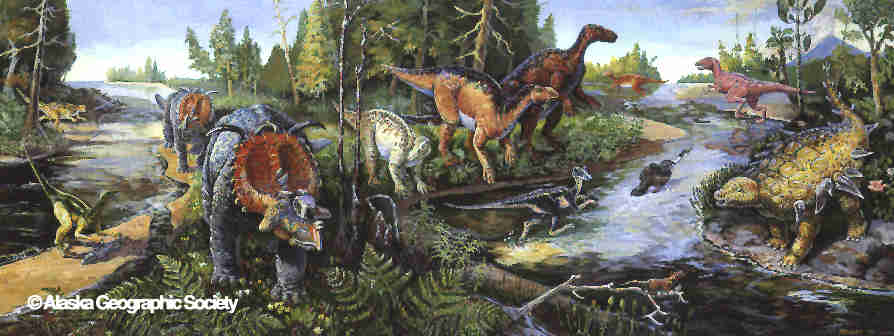 |
 |
 |
 |
 |
Produced
by the Population Genetics and Evolution class, Furman University |
||||
 |
 |
 |
 |
 |
Produced
by the Population Genetics and Evolution class, Furman University |
||||
 |
The
Cretaceous |
 |
||
 |
The Cretaceous Period was the heyday of the dinosaurs, when many of the most iconic dinosaurs flourished. Quetzalcoatlus, the largest flying animal that ever lived with a 12m wingspan, looked down on a terrestrial fauna dominated by large predators like Tyrannosaurus and smaller, pack-feeding predators like Deinonychus and Velociraptor. They fed on a wide variety of herbivorous dinosaurs, including the ceratopsians like Triceratops, and ankylosaurs, Iguanodon, and the social, duck-billed hadrosaurs.The giant sauropods were still present, like Gigantosaurus and Argentinosaurus. Deinonychus and Velociraptor were members of the Dromaeosauridae family. This group of small, bipedal theropods may have all had feathers; many fossils show feathers or associated structures. One group of dromaeosaurids, the microraptors, were feathered all over - even having flight feathers on their hind limbs. Although the dinosaurs dominated most vertebrate niches, some other groups were radiating. Most notably, the mammals were diverging, with the multituberculates still extant and ancestral monotremes like Teinolophos evolving. In addition, flowering plans evolved, represented by the oldest flowering plant fossil found to date, Archaefructus. The evolution of flowering plants stimulated the evolution of several groups of insects, particularly beetles and hymenopterans that act as pollinators. The Cretaceous ended 65 mya, with a meteor impact off the Yucatan peninsula that caused an variety of environmental and ecological catastrophes. The extinction of the dinosaurs would open ecological niches that birds and mammals would exploit in the Cenozoic Era. |
 |
||
| Above: Triceratops; Photo From: Cleveland Museum of History Below, Cretaceous scene, from: Alaska Geographic Society | Above: T. rex from: California Academy of Science Below: Cretaceous scene, from: University of Wisconsin. |
|||
 |
 |
|||